Predicting the Material Footprint in Germany between 2015 and 2020 via Seasonally Decomposed Autoregressive and Exponential Smoothing Algorithms
Abstract
1. Introduction
2. Materials
2.1. Data
- (1)
- Nutrition includes diets, food waste and all foodstuffs and drinks consumed;
- (2)
- Mobility includes everyday transport such as commuting and leisure activities by car, motorcycle, bicycle and public mobility;
- (3)
- Construction and housing include the use of energy (electricity and heating) for household purposes;
- (4)
- Consumer goods include clothes, furniture, household appliances such as refrigerators and washing machines, and consumer electronics such as TV sets and tablets;
- (5)
- Leisure activities include hobbies such as sports and cultural activities;
- (6)
- Vacations include travel and accommodation.
2.2. Weighting
3. Methods
3.1. ARIMA
3.2. ETS
3.3. STL
4. Results
4.1. Time Series Analyses
4.2. STL Predictions
5. Discussion and Conclusions
Author Contributions
Funding
Conflicts of Interest
Appendix A
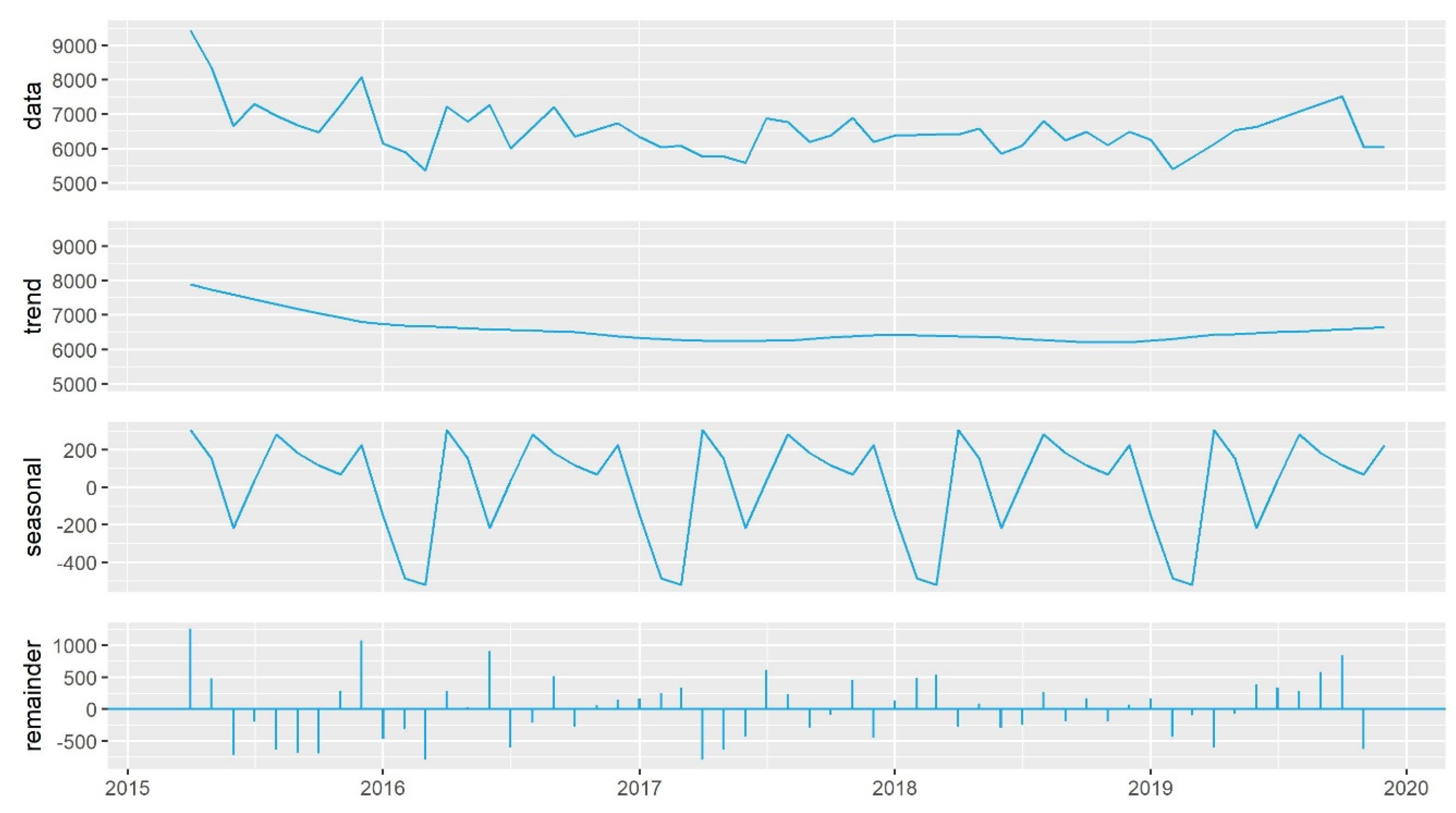
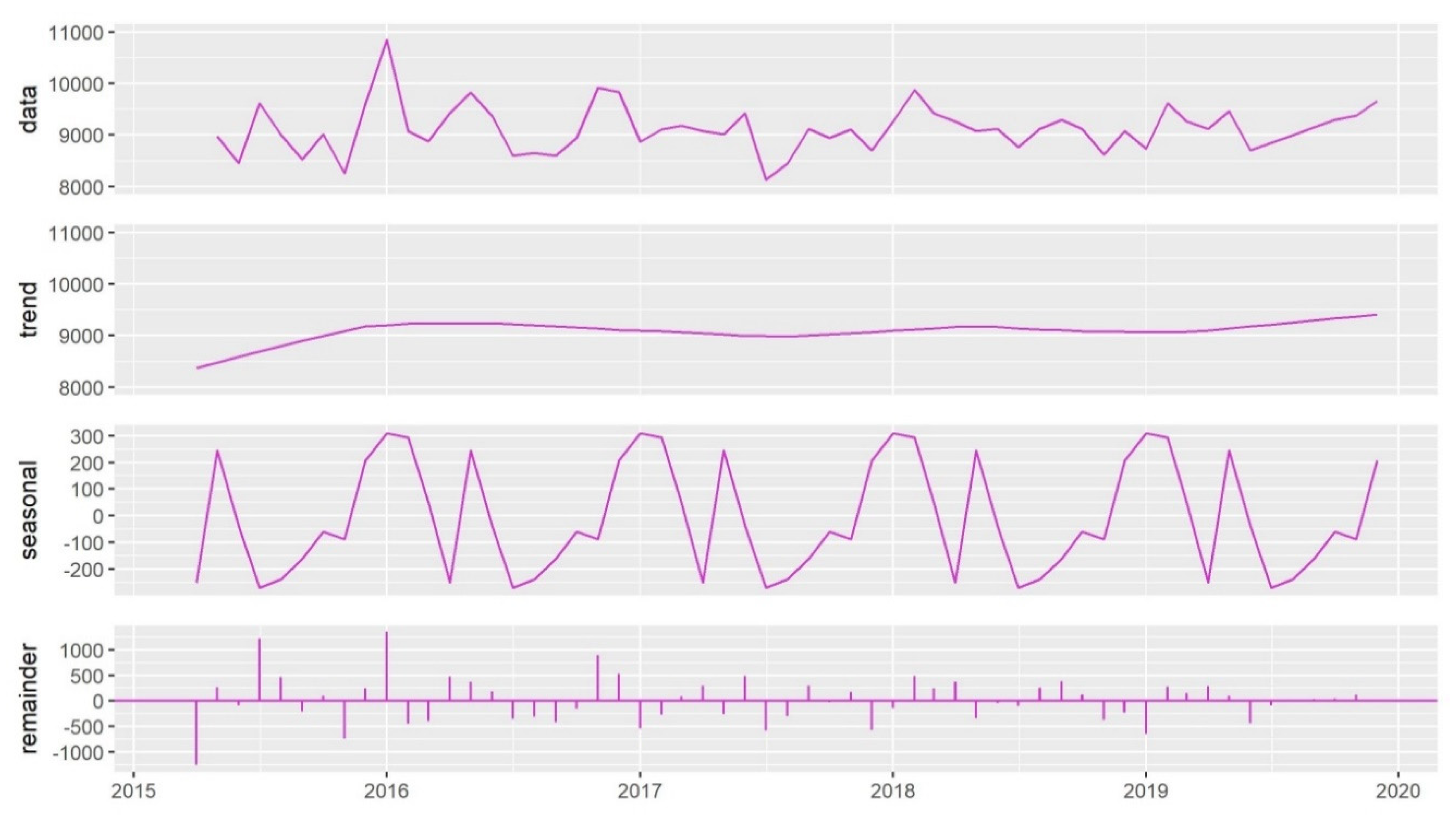
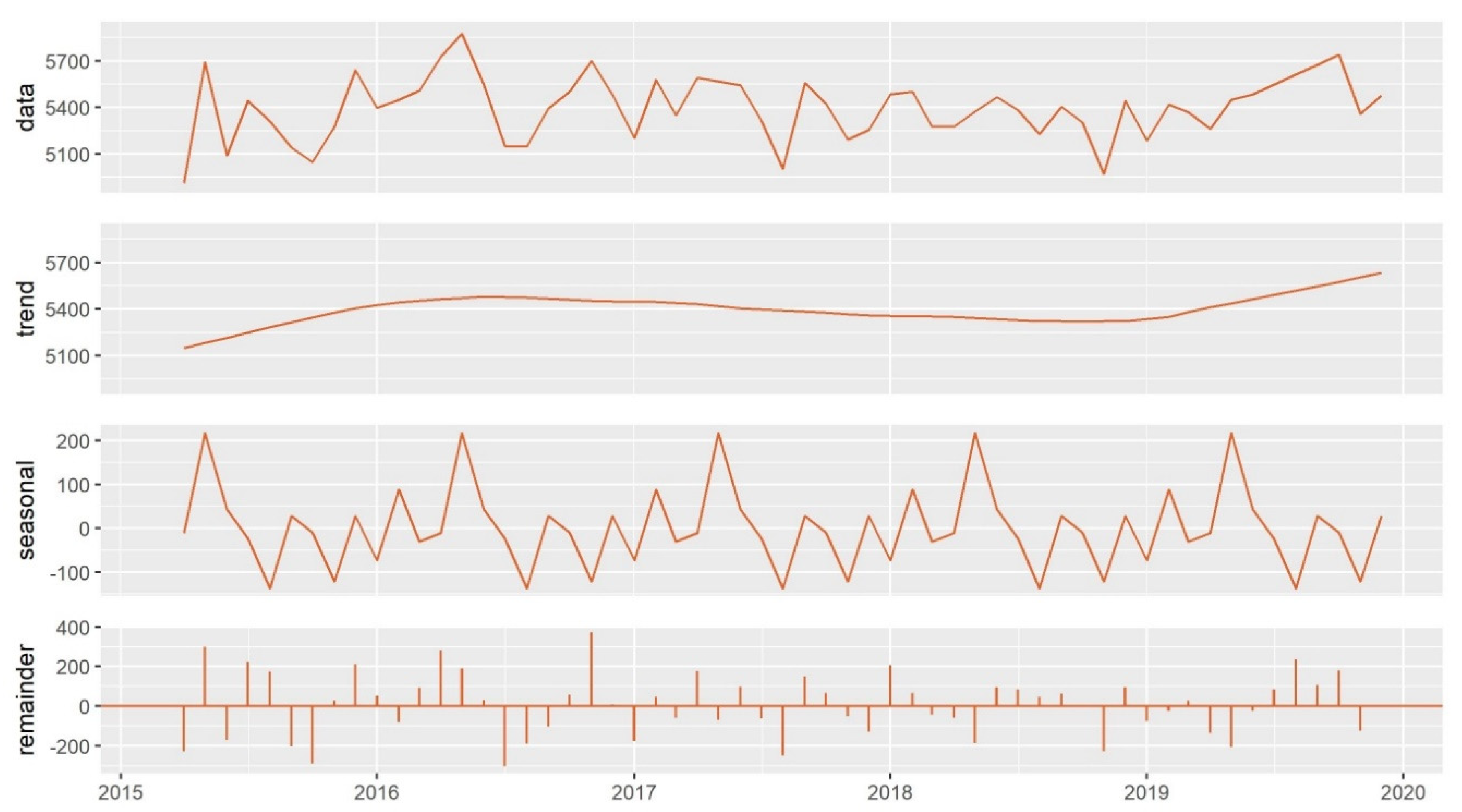
References
- Bringezu, S.; Schütz, H.; Saurat, M.; Moll, S.; Acosta-Fernández, J.; Steger, S. Europe’s resource use. Basic trends, global and sectoral patterns and environmental and socioeconomic impacts. In Sustainable Resource Management: Global Trends, Visions and Policies; Bringezu, S., Bleischwitz, R., Eds.; Greenleaf Publishing: Sheffield, UK, 2009; pp. 52–154. [Google Scholar]
- Oberle, B.; Bringezu, S.; Hatfield-Dodds, S.; Hellweg, S.; Schandl, H.; Clement, J.; Cabernard, L.; Che, N.; Chen, D.; Droz-Georget, H.; et al. Report of the International Resource Panel. United Nations Environment Programme. In Global Resources Outlook 2019: Natural Resources for the Future We Want; Nairobi, Kenya, 2019; Available online: https://resourcepanel.org/reports/global-resources-outlook (accessed on 11 October 2020).
- Lettenmeier, M.; Liedtke, C.; Rohn, H. Eight Tons of Material Footprint—Suggestion for a Resource Cap for Household Consumption in Finland. Resources 2014, 3, 488–515. [Google Scholar] [CrossRef]
- Lettenmeier, M. A Sustainable Level of Material Footprint—Benchmark for Designing One-Planet Lifestyles Materiaalijalanjäljen kestävä taso –mittapuu yhden planeetan elämäntapojen toteuttamiseen; Aalto University: Helsinki, Finland, 2018. [Google Scholar]
- Bringezu, S. Possible target corridor for sustainable use of global material resources. Resources 2015, 4, 25–54. [Google Scholar] [CrossRef]
- Bringezu, S. Toward Science-Based and Knowledge-Based Targets for Global Sustainable Resource Use. Resources 2019, 8, 140. [Google Scholar] [CrossRef]
- German Federal Government. Die Deutsche Nachhaltigkeitsstrategie 2016—Der Weg in eine enkelgerechte Zukunft; German Federal Government: Frankfurt am Main, Germany, 2016.
- UN. Transforming Our World: The 2030 Agenda for Sustainable Development. 2015. Available online: https://sustainabledevelopment.un.org/content/documents/21252030%20Agenda%20for%20Sustainable%20Development%20web.pdf (accessed on 18 April 2018).
- Domenech, T.; Bahn-Walkowiak, B. Transition towards a resource efficient circular economy in Europe: Policy lessons from the EU and the member states. Ecol. Econ. 2019, 155, 7–19. [Google Scholar] [CrossRef]
- German Federal Ministry for the Environment, Nature Conservation and Nuclear Safety (BMU 2016). German Resource Efficiency Programme II Programme for the Sustainable Use and Conservation of Natural Resources Adopted by the Federal Cabinet on 2 March 2016. 2016. Available online: https://www.bmu.de/fileadmin/Daten_BMU/Pools/Broschueren/german_resource_efficiency_programme_ii_bf.pdf (accessed on 11 October 2020).
- German Federal Statistical Office (Destatis). Umweltökonomische Gesamtrechnung. Nachhaltige Entwicklung in Deutschland Indikatoren zu Umwelt und Ökonomie, Bericht 2016; German Federal Statistical Office: Wiesbaden, Germany, 2016.
- German Federal Ministry for the Environment, Nature Conservation and Nuclear Safety (BMU 2017). Nationales Programm für nachhaltigen Konsum. Gesellschaftlicher Wandel durch einen nachhaltigen Lebensstil. Available online: http://www.bmu.de/fileadmin/Daten_BMU/Pools/Broschueren/nachhaltiger_konsum_broschuere_bf.pdf (accessed on 19 April 2018).
- Lettenmeier, M.; Rohn, H.; Liedtke, C.; Schmidt-Bleek, F. Resource Productivity in 7Steps—How to Develop Eco-Innovative Products and Services and Improve Their Material Footprint. Wuppertal Spezial 41; Wuppertal Institute for Climate, Environment and Energy: Wuppertal, Germany, 2009. [Google Scholar]
- Buhl, J.; Liedtke, C.; Teubler, J.; Bienge, K.; Schmidt, N. Measure or Management?—Resource Use Indicators for Policymakers Based on Microdata by Households. Sustainability 2018, 10, 4467. [Google Scholar] [CrossRef]
- Buhl, J.; Liedtke, C.; Teubler, J.; Schuster, S.; Bienge, K. A material footprint model for green information systems–using statistical learning to identify the predictors of natural resource use. Cogent. Eng. 2019, 6, 1616655. [Google Scholar] [CrossRef]
- Buhl, J.; Liedtke, C.; Teubler, J.; Bienge, K. The Material Footprint of private households in Germany: Linking the natural resource use and socioeconomic characteristics of users from an online footprint calculator in Germany. Sustain. Prod. Consum. 2019, 20, 74–83. [Google Scholar] [CrossRef]
- Schmidt-Bleek, F. The Earth: Natural Resources and Human Intervention; Haus Publishing: London, UK, 2009. [Google Scholar]
- Liedtke, C.; Bienge, K.; Wiesen, K.; Teubler, J.; Greiff, K.; Lettenmeier, M.; Rohn, H. Resource Use in the Production and Consumption System—The MIPS Approach. Resources 2014, 3, 544–574. [Google Scholar] [CrossRef]
- Wiesen, K.; Saurat, M.; Lettenmeier, M. Calculating the Material Input per Service Unit using the Ecoinvent Database. Int. J. Perform. Eng. 2014, 10, 357–366. [Google Scholar]
- Wiesen, K.; Wirges, M. From cumulated energy demand to cumulated raw material demand: The material footprint as a sum parameter in life cycle assessment. Energy Sustain. Soc. 2017, 7, 13. [Google Scholar] [CrossRef]
- Teubler, J.; Buhl, J.; Lettenmeier, M.; Greiff, K.; Liedtke, C. A Household’s Burden–The Embodied Resource Use of Household Equipment in Germany. Ecol. Econ. 2018, 146, 96–105. [Google Scholar] [CrossRef]
- Greiff, K.; Teubler, J.; Baedeker, C.; Liedtke, C.; Rohn, H. Material and Carbon Footprint of Household Activities. In Living Labs: Design and Assessment of Sustainable Living; Keyson, D.V., Guerra-Santin, O., Lockton, D., Eds.; Springer International Publishing: Cham, Switzerland, 2017; pp. 259–275. [Google Scholar]
- Wiedmann, T.O.; Schandl, H.; Lenzen, M.; Moran, D.; Suh, S.; West, J.; Kanemoto, K. The material footprint of nations. Proc. Natl. Acad. Sci. USA 2015, 112, 6271–6276. [Google Scholar] [CrossRef]
- Giljum, S.; Bruckner, M.; Martinez, A. Material Footprint Assessment in a Global Input-Output Framework. J. Ind. Ecol. 2015, 19, 792–804. [Google Scholar] [CrossRef]
- Lutter, S.; Giljum, S.; Bruckner, M. A review and comparative assessment of existing approaches to calculate material footprints. Ecol. Econ. 2016, 127, 1–10. [Google Scholar] [CrossRef]
- Buhl, J. Revisiting rebound effects from material resource use. Indications for Germany considering social heterogeneity. Resources 2014, 3, 106–122. [Google Scholar] [CrossRef]
- Buhl, J.; Teubler, J.; Liedtke, C.; Stadler, K. Ressourcenverbrauch private Haushalte NRW—Explorative Analyse. Final report of the funded project “Konzeptionelle Analysen und Überlegungen zur Ausgestaltung einer Nachhaltigkeitsstrategie aus wissenschaftlicher Sicht“ for the State Agency for Nature, Environment and Consumer Protection NRW (LANUV); Wuppertal Institute for Climate, Environment and Energy: Wuppertal, Germany, 2016. [Google Scholar]
- Buhl, J.; Acosta, J. Work less, do less? Working time reductions and rebound effects. Sustain. Sci. 2016, 11, 261–267. [Google Scholar] [CrossRef]
- Buhl, J.; Acosta, J. Indirect effects from resource sufficiency behaviour. In Rethinking Climate and Energy Policies. New Perspectives on the Rebound Phenomenon; Santarius, T., Walnum, H.J., Aall, C., Eds.; Springer: New York, NY, USA, 2016; pp. 37–55. [Google Scholar]
- Buhl, J.; Teubler, J.; Liedtke, C.; Stadler, K. Der Ressourcenverbrauch privater Haushalte in NRW—The resource use of private households in North Rhine-Westphalia, Germany. Uwf UmweltWirtschaftsForum Sustain. Manag. Forum 2017, 25, 255–264. [Google Scholar]
- Buhl, J.; Liedtke, C.; Bienge, K. How Much Environment Do Humans Need? Evidence from an Integrated Online User Application Linking Natural Resource Use and Subjective Well-Being in Germany. Resources 2017, 6, 67. [Google Scholar] [CrossRef]
- Gill, B.; Moeller, S. GHG emissions and the rural-urban divide. A carbon footprint analysis based on the German official income and expenditure survey. Ecol. Econ. 2018, 145, 160–169. [Google Scholar] [CrossRef]
- Junnila, S.; Ottelin, J.; Leinikka, L. Influence of Reduced Ownership on the Environmental Benefits of the Circular Economy. Sustainability 2018, 10, 4077. [Google Scholar] [CrossRef]
- Ottelin, J.; Heinonen, J.; Junnila, S. Carbon and material footprints of a welfare state: Why and how governments should enhance green investments. Environ. Sci. Policy 2018, 86, 1–10. [Google Scholar] [CrossRef]
- Pothen, F.; Reaños, T.; Angel, M. The distribution of material footprints in Germany (No. 18-022). Ecol. Econ. 2018, 153, 237–251. [Google Scholar] [CrossRef]
- German Federal Statistical Office and the Statistical Offices of the Länder. Population Depending on Age (Eleven Classes of Years) and Sex; Bayerisches Landesamt für Statistik: Fürth, Germany, 2014.
- Pasek, J.; DeBell, M.; Krosnick, J.A. Standardizing and Democratizing Survey Weights: The ANES Weighting System and Anesrake. 2014. Available online: https://surveyinsights.org/wp-content/uploads/2014/07/Full-anesrake-paper.pdf (accessed on 11 October 2020).
- Shao, Z.; Chao, F.; Yang, S.-L.; Zhou, K.-L. A review of the decomposition methodology for extracting and identifying the fluctuation characteristics in electricity demand forecasting. Renew. Sust. Energy Rev. 2017, 75, 123–136. [Google Scholar] [CrossRef]
- De Oliveira, E.M.; Oliveira, F.L.C. Forecasting mid-long term electric energy consumption through bagging ARIMA and exponential smoothing methods. Energy 2018, 144, 776–788. [Google Scholar] [CrossRef]
- Fatima, S.; Ali, S.S.; Zia, S.S.; Hussain, E.; Fraz, T.R.; Khan, M.S. Forecasting carbon dioxide emission of Asian countries using ARIMA and simple exponential smoothing models. Int. J. Econ. Environ. Geol. 2019, 10, 64–69. [Google Scholar] [CrossRef]
- Hyndman, R.J.; Khandakar, Y. Automatic Time Series for Forecasting: The Forecast Package for R (No. 6/07); Department of Econometrics and Business Statistics, Monash University: Clayton, VIC, Australia, 2007. [Google Scholar]
- Hylleberg, S.; Engle, R.; Granger, C.; Yoo, B. Seasonal integration and cointegra-tion. J. Econom. 1990, 44, 215–238. [Google Scholar] [CrossRef]
- Kwiatkowski, D.; Phillips, P.C.; Schmidt, P.; Shin, Y. Testing the null hypothesisof statioanrity against the alternative of a unit root. J. Econom. 1992, 54, 159–178. [Google Scholar] [CrossRef]
- Hyndman, R.J.; Athanasopoulos, G. Forecasting: Principles and Practice; OTexts: Melbourne, Australia, 2018. [Google Scholar]
- Cleveland, R.B.; Cleveland, W.S.; McRae, J.E.; Terpenning, I. STL: A seasonal-trend decomposition. J. Off. Stat. 1990, 6, 3–73. [Google Scholar]
- Hyndman, R.J. Measuring Forecast Accuracy. In Business Forecasting: Practical Problems and Solutions; Gilliland, M., Tashman, L., Sglavo, U., Eds.; John Wiley & Sons: New York, NY, USA, 2016; pp. 177–183. [Google Scholar]
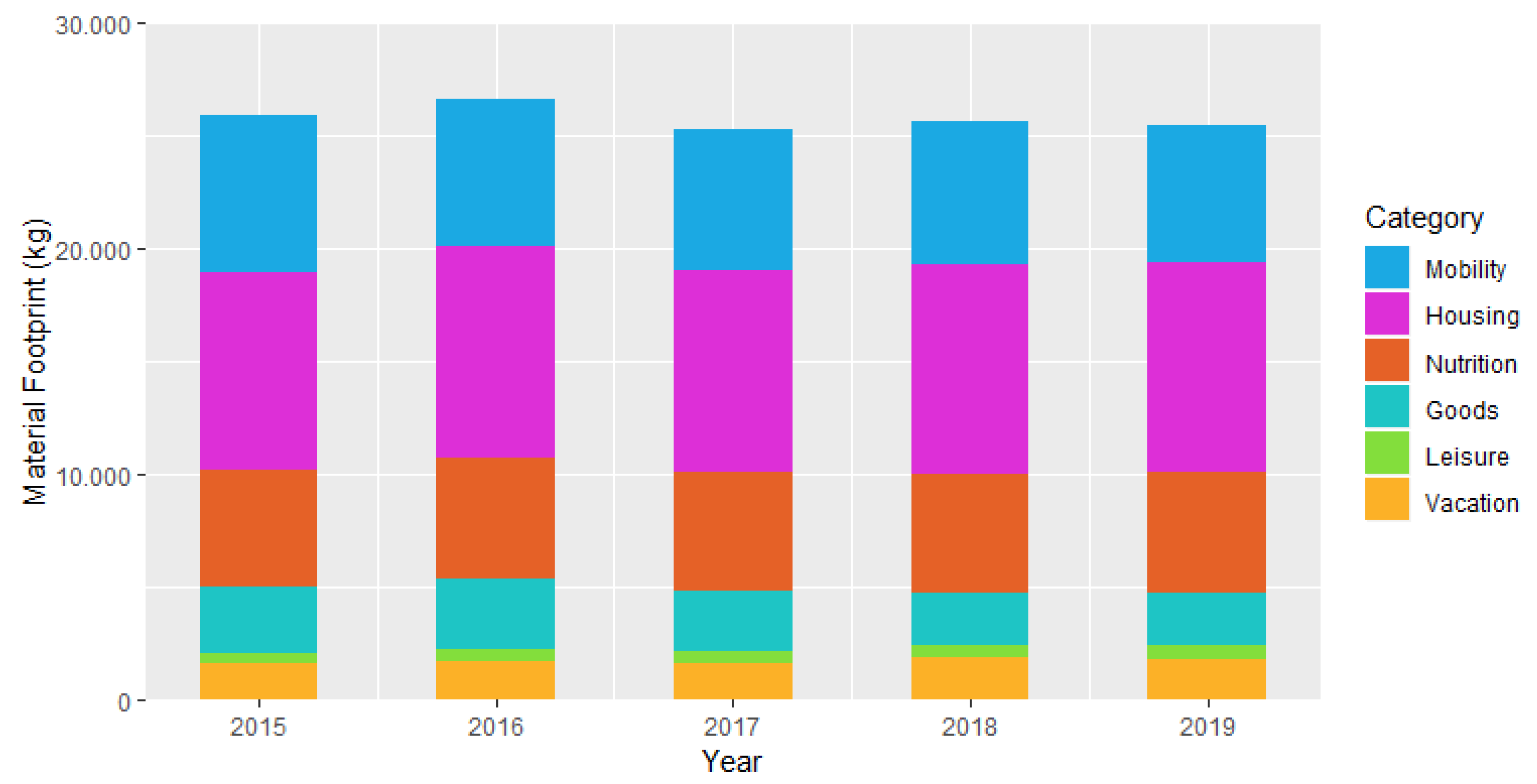
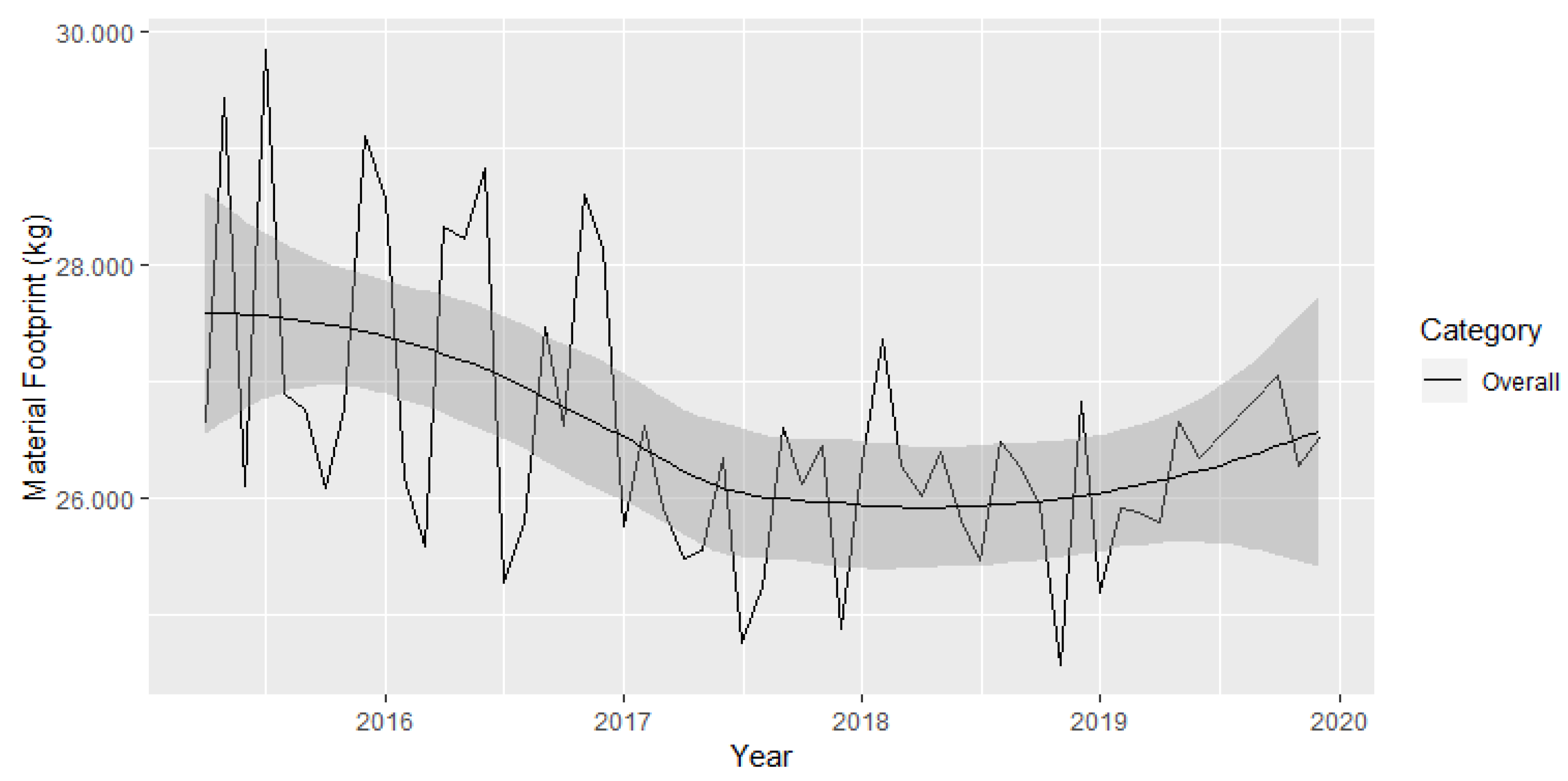
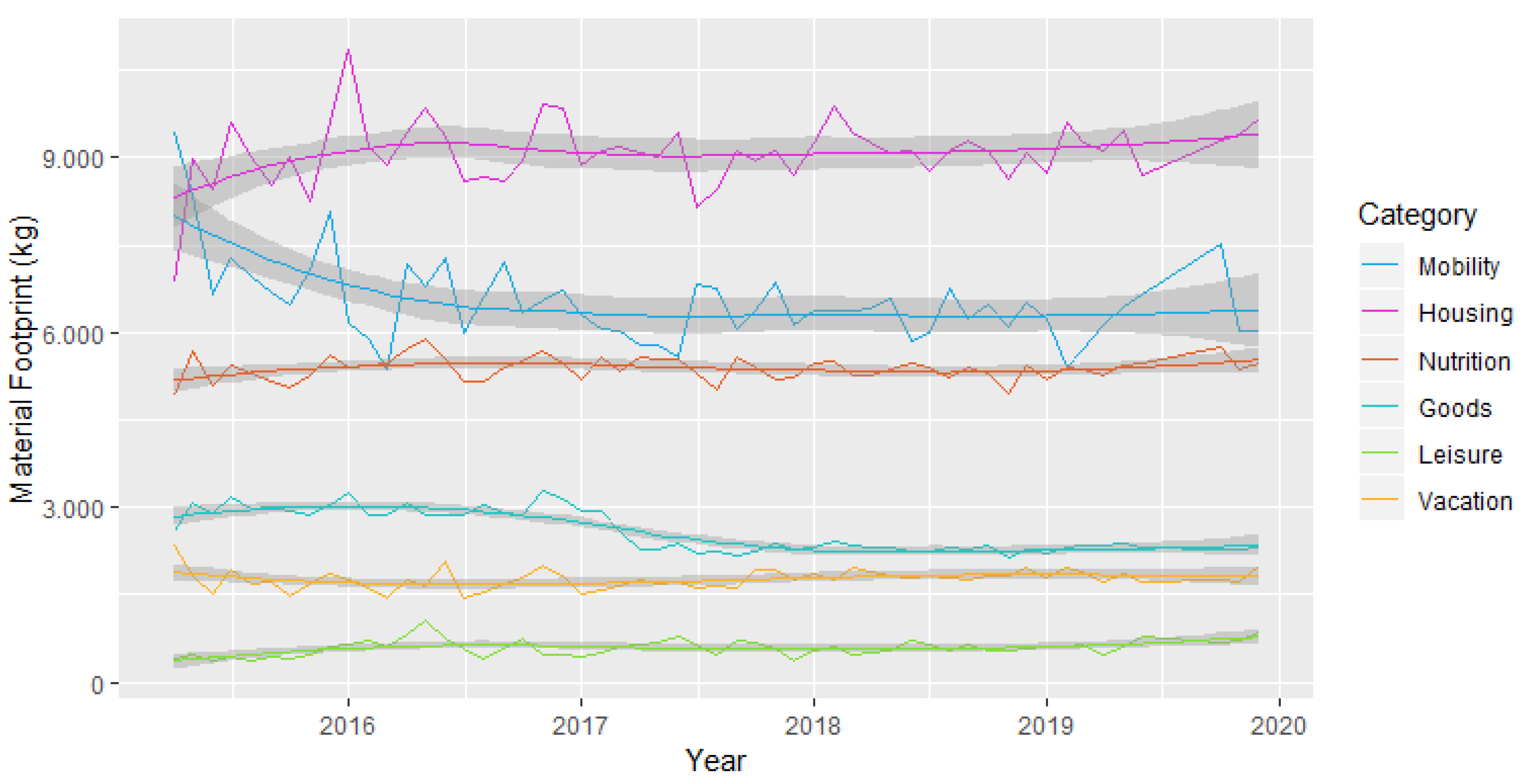

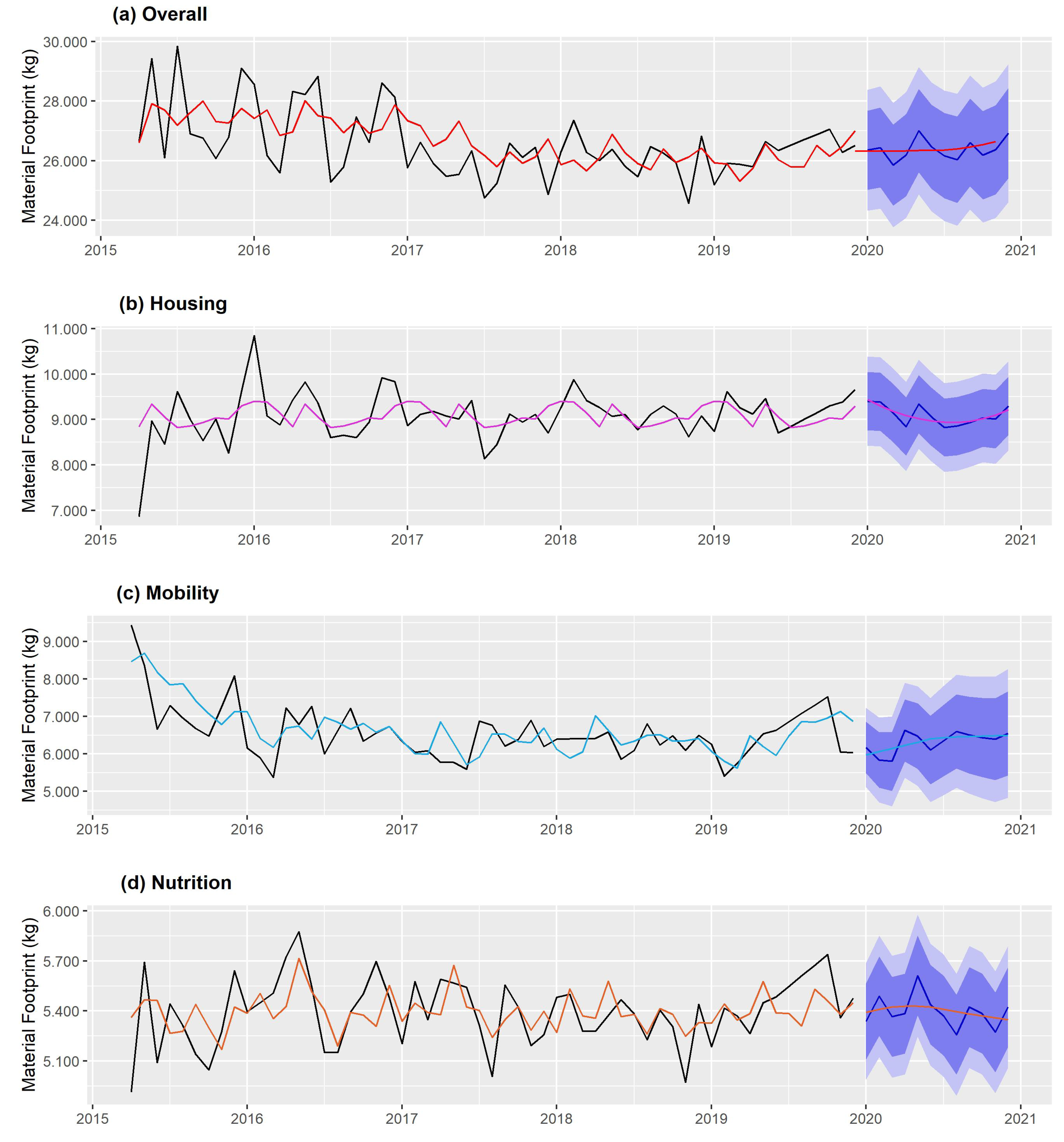
| Variable | Valid.n | Mean | sd | Min | Max |
|---|---|---|---|---|---|
| Overall (kg) | 113,559 | 25,710.88 | 9882.72 | 2711 | 74,243 |
| Housing (kg) | 113,511 | 8876.41 | 4109.29 | 45 | 28,638 |
| Mobility (kg) | 113,577 | 6472.45 | 6332.86 | 0 | 39,484 |
| Nutrition (kg) | 113,584 | 5212.58 | 1364 | 41 | 9505 |
| Goods (kg) | 113,552 | 2476.21 | 1092.74 | 0 | 6653 |
| Vacation (kg) | 113,549 | 1642.94 | 1552.68 | 0 | 8790 |
| Leisure (kg) | 113,630 | 534.54 | 781.95 | 0 | 7328 |
| Age (years) | 62,917 | 34.15 | 14.06 | 1 | 88 |
| Female (ref. male) | 63,314 | 0.63 | 0.48 | 0 | 1 |
| Sample | Male | Female | <18 | 18–25 | 25–30 | 30–40 | 40–50 | 50–65 | 65–75 | >75 |
|---|---|---|---|---|---|---|---|---|---|---|
| Observed | 0.37 | 0.63 | 0.10 | 0.18 | 0.17 | 0.25 | 0.14 | 0.14 | 0.02 | 0.01 |
| Census * | 0.49 | 0.51 | 0.16 | 0.08 | 0.06 | 0.12 | 0.17 | 0.20 | 0.11 | 0.09 |
| Weighted | 0.49 | 0.51 | 0.18 | 0.09 | 0.07 | 0.13 | 0.18 | 0.22 | 0.11 | 0.03 |
| Material Footprint | Overall | Housing | Mobility | Nutrition | ||||
|---|---|---|---|---|---|---|---|---|
| Model | STL-ARIMA | STL-ETS | STL-ARIMA | STL-ETS | STL-ARIMA | STL-ETS | STL-ARIMA | STL-ETS |
| RMSE | 849 | 1366 | 385 | 385 | 719 | 710 | 210 | 216 |
| MAE | 686 | 1215 | 330 | 331 | 607 | 599 | 154 | 161 |
| MAPE | 2.6 | 4.6 | 3.6 | 3.6 | 9.0 | 8.9 | 2.8 | 3.0 |
| MASE | 0.51 | 0.9 | 0.58 | 0.58 | 0.94 | 0.92 | 0.6 | 0.63 |
| Material Footprint | Overall (in kg) | Overall (in %) | Housing (in kg) | Housing (in %) | Mobility (in kg) | Mobility (in %) | Nutrition (in kg) | Nutrition (in %) |
|---|---|---|---|---|---|---|---|---|
| 2015 | 26,912 | - | 8743 | - | 6963 | - | 5213 | - |
| 2016 | 27,215 | 1.12 | 9310 | 6.48 | 6575 | −5.60 | 5421 | 3.99 |
| 2017 | 25,796 | −5.21 | 8921 | −4.18 | 6304 | −4.10 | 5289 | −2.43 |
| 2018 | 26,155 | 1.39 | 9213 | 3.27 | 6384 | 1.30 | 5314 | 0.47 |
| 2019 | 25,985 | −0.65 | 9253 | 0.44 | 6065 | −5.00 | 5351 | 0.69 |
| 2020 | 26,381 | 1.53 | 9094 | −1.72 | 6321 | 4.20 | 5397 | 0.86 |
Publisher’s Note: MDPI stays neutral with regard to jurisdictional claims in published maps and institutional affiliations. |
© 2020 by the authors. Licensee MDPI, Basel, Switzerland. This article is an open access article distributed under the terms and conditions of the Creative Commons Attribution (CC BY) license (http://creativecommons.org/licenses/by/4.0/).
Share and Cite
Buhl, J.; Liedtke, C.; Schuster, S.; Bienge, K. Predicting the Material Footprint in Germany between 2015 and 2020 via Seasonally Decomposed Autoregressive and Exponential Smoothing Algorithms. Resources 2020, 9, 125. https://doi.org/10.3390/resources9110125
Buhl J, Liedtke C, Schuster S, Bienge K. Predicting the Material Footprint in Germany between 2015 and 2020 via Seasonally Decomposed Autoregressive and Exponential Smoothing Algorithms. Resources. 2020; 9(11):125. https://doi.org/10.3390/resources9110125
Chicago/Turabian StyleBuhl, Johannes, Christa Liedtke, Sebastian Schuster, and Katrin Bienge. 2020. "Predicting the Material Footprint in Germany between 2015 and 2020 via Seasonally Decomposed Autoregressive and Exponential Smoothing Algorithms" Resources 9, no. 11: 125. https://doi.org/10.3390/resources9110125
APA StyleBuhl, J., Liedtke, C., Schuster, S., & Bienge, K. (2020). Predicting the Material Footprint in Germany between 2015 and 2020 via Seasonally Decomposed Autoregressive and Exponential Smoothing Algorithms. Resources, 9(11), 125. https://doi.org/10.3390/resources9110125







